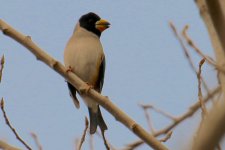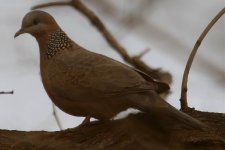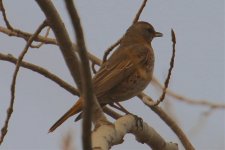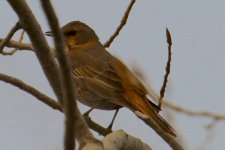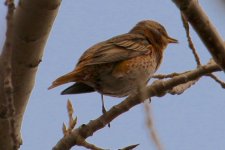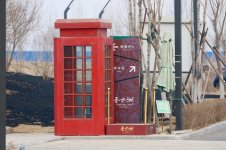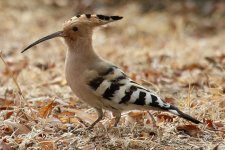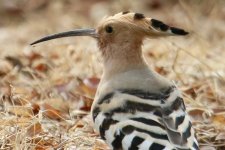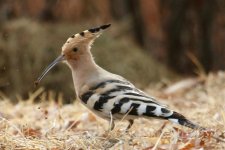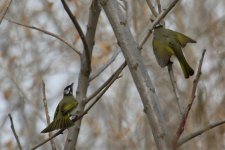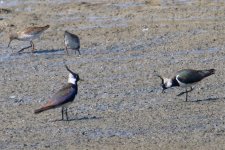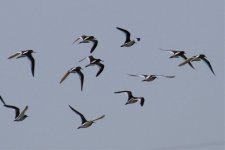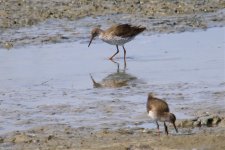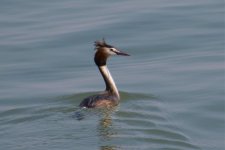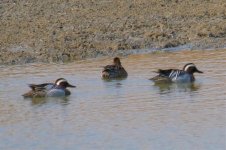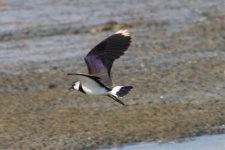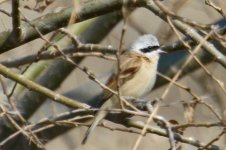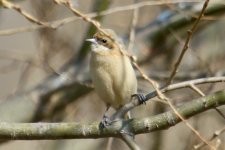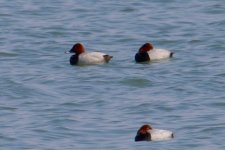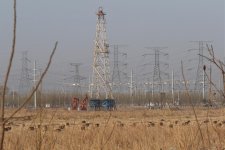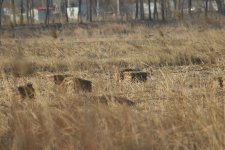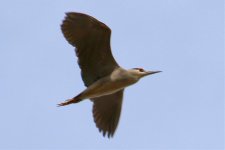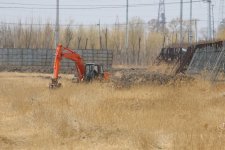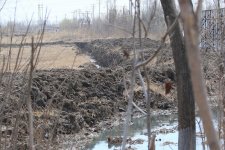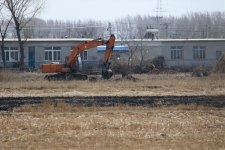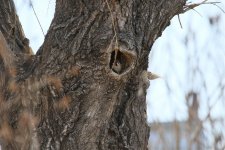-
Welcome to BirdForum, the internet's largest birding community with thousands of members from all over the world. The forums are dedicated to wild birds, birding, binoculars and equipment and all that goes with it.
Please register for an account to take part in the discussions in the forum, post your pictures in the gallery and more.
You are using an out of date browser. It may not display this or other websites correctly.
You should upgrade or use an alternative browser.
You should upgrade or use an alternative browser.
Panjin Birding by the Old Fat Man (2 Viewers)
- Thread starter Owen Krout
- Start date
More options
Who Replied?Owen Krout
Well-known member

March-04-2016
The weather was cooperative today with temps reaching +11, so I set out for the irrigation canal to spend the afternoon. Not ideal though as the lighting was terrible. Heavy smoke practically blotted out the sun at times do to agricultural burn-offs in the general area. Colors and details were difficult to make out even at 20 meters.
Continuing to see signs of the earliest of the migrating birds with (12) Chinese Grosbeak topping the list today. A nice Spotted Dove was unusually cooperative and allowed me to approach much closer than they normally will.
I have some rather poor pics of one I can't quite satisfy myself on to throw out to the crowd. Apologies but the light was very dim and the smoke heavy at the time and the subject not cooperating well. I at first sight thought it to be a probable Naumann's Thrush, but after cleaning up the image the head shape and the bill (especially the hooked upper bill) and general color seem wrong. There was another bird I judged as a Dusky/Naumann's nearby shortly before. It could just be that the light was so poor that the camera failed to capture the true coloration, but normally, even in low light, this camera does render colors quite true.
The weather was cooperative today with temps reaching +11, so I set out for the irrigation canal to spend the afternoon. Not ideal though as the lighting was terrible. Heavy smoke practically blotted out the sun at times do to agricultural burn-offs in the general area. Colors and details were difficult to make out even at 20 meters.
Continuing to see signs of the earliest of the migrating birds with (12) Chinese Grosbeak topping the list today. A nice Spotted Dove was unusually cooperative and allowed me to approach much closer than they normally will.
I have some rather poor pics of one I can't quite satisfy myself on to throw out to the crowd. Apologies but the light was very dim and the smoke heavy at the time and the subject not cooperating well. I at first sight thought it to be a probable Naumann's Thrush, but after cleaning up the image the head shape and the bill (especially the hooked upper bill) and general color seem wrong. There was another bird I judged as a Dusky/Naumann's nearby shortly before. It could just be that the light was so poor that the camera failed to capture the true coloration, but normally, even in low light, this camera does render colors quite true.
Attachments
Owen Krout
Well-known member

Also dropped by "Perfume Lake" which is part of a new development. It might actually provide some water birds for a year or two if I am lucky. A lot of open water and land around it right now, but unfortunately the development plans show it to eventually given over to heavy development. I think something was lost in the translation however as I would say odoriferous was more accurate. 
Also seems that Dr. Who was paying a visit.
Also seems that Dr. Who was paying a visit.
Attachments
Owen Krout
Well-known member

Just realized that I forgot the full list for the 4th.
Panjin, Dawa County, Liaoning, CN, Liaoning, CN
Mar 4, 2016 12:30 PM - 4:45 PM
Protocol: Traveling
8.0 kilometer(s)
15 species (+1 other taxa)
Spotted Dove (Streptopelia chinensis) 1
Great Spotted Woodpecker (Dendrocopos major) 1
Gray-headed Woodpecker (Picus canus) 3
Eurasian Magpie (Pica pica) 6
Coal Tit (Periparus ater) 5
Japanese Tit (Parus minor) 5
Eurasian Nuthatch (Sitta europaea) 1
Eurasian Treecreeper (Certhia familiaris) 3
Light-vented Bulbul (Pycnonotus sinensis) 20
Dusky/Naumann's Thrush (Turdus naumanni/eunomus) 1
Little Bunting (Emberiza pusilla) 37
Rustic Bunting (Emberiza rustica) 4
Yellow-throated Bunting (Emberiza elegans) 6
Brambling (Fringilla montifringilla) 2
Yellow-billed Grosbeak (Eophona migratoria) 12
Eurasian Tree Sparrow (Passer montanus) 25
View this checklist online at http://ebird.org/ebird/view/checklist?subID=S27958814
This report was generated automatically by eBird v3 (http://ebird.org)
Panjin, Dawa County, Liaoning, CN, Liaoning, CN
Mar 4, 2016 12:30 PM - 4:45 PM
Protocol: Traveling
8.0 kilometer(s)
15 species (+1 other taxa)
Spotted Dove (Streptopelia chinensis) 1
Great Spotted Woodpecker (Dendrocopos major) 1
Gray-headed Woodpecker (Picus canus) 3
Eurasian Magpie (Pica pica) 6
Coal Tit (Periparus ater) 5
Japanese Tit (Parus minor) 5
Eurasian Nuthatch (Sitta europaea) 1
Eurasian Treecreeper (Certhia familiaris) 3
Light-vented Bulbul (Pycnonotus sinensis) 20
Dusky/Naumann's Thrush (Turdus naumanni/eunomus) 1
Little Bunting (Emberiza pusilla) 37
Rustic Bunting (Emberiza rustica) 4
Yellow-throated Bunting (Emberiza elegans) 6
Brambling (Fringilla montifringilla) 2
Yellow-billed Grosbeak (Eophona migratoria) 12
Eurasian Tree Sparrow (Passer montanus) 25
View this checklist online at http://ebird.org/ebird/view/checklist?subID=S27958814
This report was generated automatically by eBird v3 (http://ebird.org)
Owen Krout
Well-known member

March-06-2016
Only a short list for today, but the best pics I have managed of a Hoopoe to date. Also a pic of a couple of Light-Vented (Chinese) Bulbul in the middle of an elaborate mating display.
Panjin, Dawa County, Liaoning, CN, Liaoning, CN
Mar 6, 2016 12:15 PM - 1:30 PM
Protocol: Traveling
3.5 kilometer(s)
5 species
Eurasian Hoopoe (Upupa epops) 1
Eurasian Magpie (Pica pica) 3
Light-vented Bulbul (Pycnonotus sinensis) 4
Little Bunting (Emberiza pusilla) 1
Eurasian Tree Sparrow (Passer montanus) 107
View this checklist online at http://ebird.org/ebird/view/checklist?subID=S27993537
This report was generated automatically by eBird v3 (http://ebird.org)
Only a short list for today, but the best pics I have managed of a Hoopoe to date. Also a pic of a couple of Light-Vented (Chinese) Bulbul in the middle of an elaborate mating display.
Panjin, Dawa County, Liaoning, CN, Liaoning, CN
Mar 6, 2016 12:15 PM - 1:30 PM
Protocol: Traveling
3.5 kilometer(s)
5 species
Eurasian Hoopoe (Upupa epops) 1
Eurasian Magpie (Pica pica) 3
Light-vented Bulbul (Pycnonotus sinensis) 4
Little Bunting (Emberiza pusilla) 1
Eurasian Tree Sparrow (Passer montanus) 107
View this checklist online at http://ebird.org/ebird/view/checklist?subID=S27993537
This report was generated automatically by eBird v3 (http://ebird.org)
Attachments
Hi Owen,
Nice pictures! It's interesting to see the mating display, which I really haven't paid close attention to - but I guess now is the time! I did notice the Chinese bulbuls I saw today were still kind of in a flock....
By the way, a few posts up, I assume that your bird was a Naumann's Thrush, but maybe you or someone else has another idea?
Nice pictures! It's interesting to see the mating display, which I really haven't paid close attention to - but I guess now is the time! I did notice the Chinese bulbuls I saw today were still kind of in a flock....
By the way, a few posts up, I assume that your bird was a Naumann's Thrush, but maybe you or someone else has another idea?
Owen Krout
Well-known member

Hello Gretchen,
Naumann's was what I thought when I saw it visually, it was after I tried some processing on the photo that it just didn't look right to me. Reviewing it again today I am even more inclined towards the really bad lighting theory and that it was indeed a Naumann's.
The Bulbuls had quite an elaborate display "dance". Unfortunately, I had a bad angle on them and it was mostly too obscured by the brush to get photos. It started with the pair flying in together and displaying by fluttering their wings and tails while facing each other for a minute or so and then flying up together, still facing each other and very close, almost touching while fluttering their wings and chattering and finally, similar to the territorial display that one often sees, swooping back down to the same perch to start the whole thing over again.
Naumann's was what I thought when I saw it visually, it was after I tried some processing on the photo that it just didn't look right to me. Reviewing it again today I am even more inclined towards the really bad lighting theory and that it was indeed a Naumann's.
The Bulbuls had quite an elaborate display "dance". Unfortunately, I had a bad angle on them and it was mostly too obscured by the brush to get photos. It started with the pair flying in together and displaying by fluttering their wings and tails while facing each other for a minute or so and then flying up together, still facing each other and very close, almost touching while fluttering their wings and chattering and finally, similar to the territorial display that one often sees, swooping back down to the same perch to start the whole thing over again.
Owen Krout
Well-known member

Back today after a bout of food poisoning. Still not up to par, but blue skies, warm temps and only a light breeze drew me out for a short walk in the immediate area despite the objections of family that I wasn't ready for that yet. Only bins, no camera as I did not feel like touting the extra weight.
Nothing really special except territorial and mating behavior being much more evident. The Bulbul were calling, displaying and mating. Hoopoe were calling loudly and the Great Spotted Woodpecker were a couple of males drumming, vocalizing and chasing each other.
Hmm. Just noticed that I left out the single Japanese Grosbeak sitting in the middle of a group of Bulbul. Wouldn't have noticed it if I hadn't been using the bins to try and get a count on the Bulbul. Usually only see Grosbeak as part of a flock.
The ice is almost entirely gone. The original plan was to make a trip to Gedalou Reservoir today to look for shorebirds and waterbirds, so hopefully will make it either to there or the Shangtaizi River Estuary area as soon as I am up to it.
Panjin, Dawa County, Liaoning, CN, Liaoning, CN
Mar 20, 2016 11:30 AM - 1:00 PM
Protocol: Traveling
1.5 kilometer(s)
9 species
Eurasian Hoopoe (Upupa epops) 3
Great Spotted Woodpecker (Dendrocopos major) 2
Eurasian Kestrel (Falco tinnunculus) 1
Azure-winged Magpie (Cyanopica cyanus) 2
Eurasian Magpie (Pica pica) 6
Long-tailed Tit (Aegithalos caudatus) 1
Light-vented Bulbul (Pycnonotus sinensis) 19
Yellow-throated Bunting (Emberiza elegans) 3
Eurasian Tree Sparrow (Passer montanus) 40
View this checklist online at http://ebird.org/ebird/view/checklist?subID=S28438546
This report was generated automatically by eBird v3 (http://ebird.org)
Nothing really special except territorial and mating behavior being much more evident. The Bulbul were calling, displaying and mating. Hoopoe were calling loudly and the Great Spotted Woodpecker were a couple of males drumming, vocalizing and chasing each other.
Hmm. Just noticed that I left out the single Japanese Grosbeak sitting in the middle of a group of Bulbul. Wouldn't have noticed it if I hadn't been using the bins to try and get a count on the Bulbul. Usually only see Grosbeak as part of a flock.
The ice is almost entirely gone. The original plan was to make a trip to Gedalou Reservoir today to look for shorebirds and waterbirds, so hopefully will make it either to there or the Shangtaizi River Estuary area as soon as I am up to it.
Panjin, Dawa County, Liaoning, CN, Liaoning, CN
Mar 20, 2016 11:30 AM - 1:00 PM
Protocol: Traveling
1.5 kilometer(s)
9 species
Eurasian Hoopoe (Upupa epops) 3
Great Spotted Woodpecker (Dendrocopos major) 2
Eurasian Kestrel (Falco tinnunculus) 1
Azure-winged Magpie (Cyanopica cyanus) 2
Eurasian Magpie (Pica pica) 6
Long-tailed Tit (Aegithalos caudatus) 1
Light-vented Bulbul (Pycnonotus sinensis) 19
Yellow-throated Bunting (Emberiza elegans) 3
Eurasian Tree Sparrow (Passer montanus) 40
View this checklist online at http://ebird.org/ebird/view/checklist?subID=S28438546
This report was generated automatically by eBird v3 (http://ebird.org)
Owen Krout
Well-known member

March 25 2016
I finally managed to make it to Gedalou Reservoir yesterday and was rewarded with five lifers. Immediately on arriving and while the wife was still complaining that we just wasted 30 RMB because everyone assured her that there no birds had arrived yet, I stepped up to the wall that surrounds the reservoir and there floating on the water were (300) Common Coot to our right and a good (150) Black Headed Gull to the left.
I grabbed some quick pics and did a quick scan with the binoculars and caught a glimpse of what looked very much like (4) White-Naped Crane descending into the fallow fields near the lake. Too far away to be certain on ID though. Flew with slow downbeats and long legs and neck extended. We immediately started towards that area, but we were distracted by a large gathering of waders and gulls at a recently drained fish pond and by the time we arrived at the fields, they were gone.
The drained pond yielded a good selection though I had to work at distance as everything was very shy. A new favorite from there is the (48) Northern Lapwing. The (48) Common Redshank had me puzzled for a few minutes due to most having their legs and bills sheathed in mud but I managed to make out a few who were cleaner. A group of Black Headed Gull foraged with them and I almost missed noticing (4) Common Mersanger who were quietly sitting on the water barely deep enough to float them.
Noticing all the noise from an adjacent pond we moved over and were amazed by (350) Black-Headed Gull working over a somewhat dryer pond bed along with some Northern Lapwing.
Just then a wild commotion erupted on the first pond and I turned just in time to see a Peregrine Falcon making a pass on the Lapwing. As the gulls escaped, the Lapwing flock was pressed down to where their feet were in the water and their wing tips were slapping the water. The falcon knocked one down into the water but apparently was unwilling to get dirty and wet and broke off the attack. The victim managed to struggle back into the air and rejoined the flock as the all decided to continue the migration and disappeared to the north.
As we started to leave the now empty ponds I noticed activity in the reeds alongside the pathway and with quite a bit of work managed (20) Chinese Penduline-Tit, (4) Little Bunting and (4) Reed Bunting.
Other notables were (4) Garganey who were flushed out by one of the aggressive Great Crested Grebe. I also managed to see but not photo (5) Water Pipit, which is good as the reed bed near home where I first saw them earlier this spring has now been entirely filled in.
We finished up with (72) Common Pochard who were sleeping on the water at the south end of the lake. All in all a good day.
I finally managed to make it to Gedalou Reservoir yesterday and was rewarded with five lifers. Immediately on arriving and while the wife was still complaining that we just wasted 30 RMB because everyone assured her that there no birds had arrived yet, I stepped up to the wall that surrounds the reservoir and there floating on the water were (300) Common Coot to our right and a good (150) Black Headed Gull to the left.
I grabbed some quick pics and did a quick scan with the binoculars and caught a glimpse of what looked very much like (4) White-Naped Crane descending into the fallow fields near the lake. Too far away to be certain on ID though. Flew with slow downbeats and long legs and neck extended. We immediately started towards that area, but we were distracted by a large gathering of waders and gulls at a recently drained fish pond and by the time we arrived at the fields, they were gone.
The drained pond yielded a good selection though I had to work at distance as everything was very shy. A new favorite from there is the (48) Northern Lapwing. The (48) Common Redshank had me puzzled for a few minutes due to most having their legs and bills sheathed in mud but I managed to make out a few who were cleaner. A group of Black Headed Gull foraged with them and I almost missed noticing (4) Common Mersanger who were quietly sitting on the water barely deep enough to float them.
Noticing all the noise from an adjacent pond we moved over and were amazed by (350) Black-Headed Gull working over a somewhat dryer pond bed along with some Northern Lapwing.
Just then a wild commotion erupted on the first pond and I turned just in time to see a Peregrine Falcon making a pass on the Lapwing. As the gulls escaped, the Lapwing flock was pressed down to where their feet were in the water and their wing tips were slapping the water. The falcon knocked one down into the water but apparently was unwilling to get dirty and wet and broke off the attack. The victim managed to struggle back into the air and rejoined the flock as the all decided to continue the migration and disappeared to the north.
As we started to leave the now empty ponds I noticed activity in the reeds alongside the pathway and with quite a bit of work managed (20) Chinese Penduline-Tit, (4) Little Bunting and (4) Reed Bunting.
Other notables were (4) Garganey who were flushed out by one of the aggressive Great Crested Grebe. I also managed to see but not photo (5) Water Pipit, which is good as the reed bed near home where I first saw them earlier this spring has now been entirely filled in.
We finished up with (72) Common Pochard who were sleeping on the water at the south end of the lake. All in all a good day.
Attachments
Owen Krout
Well-known member

The list and some more pics
Gedalou Reservoir, Panjin, Dawa County, Liaoning, CN, Liaoning, CN
Mar 25, 2016 1:00 PM - 2:30 PM
Protocol: Traveling
2.0 kilometer(s)
16 species
Garganey (Anas querquedula) 4
Common Pochard (Aythya ferina) 72
Common Merganser (Mergus merganser) 4
Great Crested Grebe (Podiceps cristatus) 10
Eurasian Coot (Fulica atra) 300
Northern Lapwing (Vanellus vanellus) 45
Common Redshank (Tringa totanus) 48
Black-headed Gull (Chroicocephalus ridibundus) 550
Herring Gull (Mongolian) (Larus argentatus mongolicus) 6
Peregrine Falcon (Falco peregrinus) 1
Eurasian Magpie (Pica pica) 4
Chinese Penduline-Tit (Remiz consobrinus) 20
Water Pipit (Anthus spinoletta) 5
Little Bunting (Emberiza pusilla) 4
Reed Bunting (Emberiza schoeniclus) 4
Eurasian Tree Sparrow (Passer montanus) 60
View this checklist online at http://ebird.org/ebird/view/checklist?subID=S28531084
This report was generated automatically by eBird v3 (http://ebird.org)
Gedalou Reservoir, Panjin, Dawa County, Liaoning, CN, Liaoning, CN
Mar 25, 2016 1:00 PM - 2:30 PM
Protocol: Traveling
2.0 kilometer(s)
16 species
Garganey (Anas querquedula) 4
Common Pochard (Aythya ferina) 72
Common Merganser (Mergus merganser) 4
Great Crested Grebe (Podiceps cristatus) 10
Eurasian Coot (Fulica atra) 300
Northern Lapwing (Vanellus vanellus) 45
Common Redshank (Tringa totanus) 48
Black-headed Gull (Chroicocephalus ridibundus) 550
Herring Gull (Mongolian) (Larus argentatus mongolicus) 6
Peregrine Falcon (Falco peregrinus) 1
Eurasian Magpie (Pica pica) 4
Chinese Penduline-Tit (Remiz consobrinus) 20
Water Pipit (Anthus spinoletta) 5
Little Bunting (Emberiza pusilla) 4
Reed Bunting (Emberiza schoeniclus) 4
Eurasian Tree Sparrow (Passer montanus) 60
View this checklist online at http://ebird.org/ebird/view/checklist?subID=S28531084
This report was generated automatically by eBird v3 (http://ebird.org)
Attachments
Owen Krout
Well-known member

March 26 2016
An hour and a half this afternoon in magnificent weather.
Panjin, Dawa County, Liaoning, CN, Liaoning, CN
Mar 26, 2016 12:15 PM - 1:45 PM
Protocol: Traveling
2.0 kilometer(s)
11 species
Eurasian Hoopoe (Upupa epops) 1
Great Spotted Woodpecker (Dendrocopos major) 1
Gray-headed Woodpecker (Picus canus) 1
Azure-winged Magpie (Cyanopica cyanus) 12
Eurasian Magpie (Pica pica) 2
Japanese Tit (Parus minor) 2
Light-vented Bulbul (Pycnonotus sinensis) 1
White Wagtail (ocularis) (Motacilla alba ocularis) 1
Olive-backed Pipit (Anthus hodgsoni) 7
Brambling (Fringilla montifringilla) 1
Eurasian Tree Sparrow (Passer montanus) 30
View this checklist online at http://ebird.org/ebird/view/checklist?subID=S28546613
This report was generated automatically by eBird v3 (http://ebird.org)
An hour and a half this afternoon in magnificent weather.
Panjin, Dawa County, Liaoning, CN, Liaoning, CN
Mar 26, 2016 12:15 PM - 1:45 PM
Protocol: Traveling
2.0 kilometer(s)
11 species
Eurasian Hoopoe (Upupa epops) 1
Great Spotted Woodpecker (Dendrocopos major) 1
Gray-headed Woodpecker (Picus canus) 1
Azure-winged Magpie (Cyanopica cyanus) 12
Eurasian Magpie (Pica pica) 2
Japanese Tit (Parus minor) 2
Light-vented Bulbul (Pycnonotus sinensis) 1
White Wagtail (ocularis) (Motacilla alba ocularis) 1
Olive-backed Pipit (Anthus hodgsoni) 7
Brambling (Fringilla montifringilla) 1
Eurasian Tree Sparrow (Passer montanus) 30
View this checklist online at http://ebird.org/ebird/view/checklist?subID=S28546613
This report was generated automatically by eBird v3 (http://ebird.org)
Owen Krout
Well-known member

March 27 2016
Thanks, Tom. Getting into the time of the year where keeping the photos organized and weeding out the chaff can become a task at times, which is a good thing for me since getting those really good shots is a big part of the fun for me.
Made a swing by the reed beds near home in the last few days and though only the beginnings of the migration evident there were some concerning signs. First of all, as I already mentioned the smaller bed of maybe 3 hectare where I first spotted the Water Pipit has been completely filled in, apparently for an expansion of the private school it abuts. I also noted that the larger reed beds of perhaps 15 hectare, directly across the road, which have been untouched due to a development project abandoned when the local government instituted a five year development freeze, had the reeds cut down across its expanse this year. I am hoping that it was connected with the Dawa Winter Straw Art Festival which had displays, some quite large and/or elaborate, springing up everywhere. So far no other signs of activity.
Just west of that are even larger beds which have had increased oil and/or natural gas drilling activity, but minimal disturbance of the reeds up until now. Not only were the reeds cut down but they were obviously done with machinery as they were bailed. A new fire station was built on the edge of this last year and they had dug out a pond directly behind it. I assume for an emergency water supply and several ditches were either new or deepened. Nobody seems to appreciate the importance of the wetlands to the overall environment. :-C
A related point to all this is that the hydrology of this area somewhat fascinates me, but not being a Civil Engineer I don't really understand it. We, as is most of North-East China, are in the middle of a severe drought. I estimate that we actually received no more than 2-3 centimeters of moisture since November first, but one can actually observe the water rising even in reed beds which are now cut off and have no connection to any stream, canal or lake. Even in the irrigation canal, which has not been flooded yet, the water is slowly rising. Apparently snow melt from the mountains slowly works its way to here and resurfaces. My wife was recruited to teach in Panjin back in the mid '80s when it was first being established and refused the position on the basis of it being one big swamp. The whole place is built on filled in land.
On the latest swing through that area. The migration appears to be a bit delayed from what it was last spring with the Bluetail and Buntings just now starting to return. I did spot a small group of White-cheeked Starling.
Panjin, Dawa County, Liaoning, CN, Liaoning, CN
Mar 27, 2016 12:15 PM - 2:45 PM
Protocol: Traveling
5.0 kilometer(s)
11 species
Eurasian Hoopoe (Upupa epops) 1
Eurasian Kestrel (Falco tinnunculus) 1
Eurasian Magpie (Pica pica) 5
Light-vented Bulbul (Pycnonotus sinensis) 1
Red-flanked Bluetail (Tarsiger cyanurus) 1
White-cheeked Starling (Spodiopsar cineraceus) 5
Chestnut-eared Bunting (Emberiza fucata) 4
Little Bunting (Emberiza pusilla) 15
Yellow-throated Bunting (Emberiza elegans) 30
Brambling (Fringilla montifringilla) 1
Eurasian Tree Sparrow (Passer montanus) 30
View this checklist online at http://ebird.org/ebird/view/checklist?subID=S28609679
This report was generated automatically by eBird v3 (http://ebird.org)
Thanks, Tom. Getting into the time of the year where keeping the photos organized and weeding out the chaff can become a task at times, which is a good thing for me since getting those really good shots is a big part of the fun for me.
Made a swing by the reed beds near home in the last few days and though only the beginnings of the migration evident there were some concerning signs. First of all, as I already mentioned the smaller bed of maybe 3 hectare where I first spotted the Water Pipit has been completely filled in, apparently for an expansion of the private school it abuts. I also noted that the larger reed beds of perhaps 15 hectare, directly across the road, which have been untouched due to a development project abandoned when the local government instituted a five year development freeze, had the reeds cut down across its expanse this year. I am hoping that it was connected with the Dawa Winter Straw Art Festival which had displays, some quite large and/or elaborate, springing up everywhere. So far no other signs of activity.
Just west of that are even larger beds which have had increased oil and/or natural gas drilling activity, but minimal disturbance of the reeds up until now. Not only were the reeds cut down but they were obviously done with machinery as they were bailed. A new fire station was built on the edge of this last year and they had dug out a pond directly behind it. I assume for an emergency water supply and several ditches were either new or deepened. Nobody seems to appreciate the importance of the wetlands to the overall environment. :-C
A related point to all this is that the hydrology of this area somewhat fascinates me, but not being a Civil Engineer I don't really understand it. We, as is most of North-East China, are in the middle of a severe drought. I estimate that we actually received no more than 2-3 centimeters of moisture since November first, but one can actually observe the water rising even in reed beds which are now cut off and have no connection to any stream, canal or lake. Even in the irrigation canal, which has not been flooded yet, the water is slowly rising. Apparently snow melt from the mountains slowly works its way to here and resurfaces. My wife was recruited to teach in Panjin back in the mid '80s when it was first being established and refused the position on the basis of it being one big swamp. The whole place is built on filled in land.
On the latest swing through that area. The migration appears to be a bit delayed from what it was last spring with the Bluetail and Buntings just now starting to return. I did spot a small group of White-cheeked Starling.
Panjin, Dawa County, Liaoning, CN, Liaoning, CN
Mar 27, 2016 12:15 PM - 2:45 PM
Protocol: Traveling
5.0 kilometer(s)
11 species
Eurasian Hoopoe (Upupa epops) 1
Eurasian Kestrel (Falco tinnunculus) 1
Eurasian Magpie (Pica pica) 5
Light-vented Bulbul (Pycnonotus sinensis) 1
Red-flanked Bluetail (Tarsiger cyanurus) 1
White-cheeked Starling (Spodiopsar cineraceus) 5
Chestnut-eared Bunting (Emberiza fucata) 4
Little Bunting (Emberiza pusilla) 15
Yellow-throated Bunting (Emberiza elegans) 30
Brambling (Fringilla montifringilla) 1
Eurasian Tree Sparrow (Passer montanus) 30
View this checklist online at http://ebird.org/ebird/view/checklist?subID=S28609679
This report was generated automatically by eBird v3 (http://ebird.org)
Attachments
Owen, I agree about the drought. Reservoirs here have been getting steadily lower for the last 2-3 years. It can be depressing watching fine habitat like reed bed disappear but I think you are right in saying there has been a freeze. Development in the area where I live has all but stopped suddenly 1-2 years ago. Between 2010-2013 it was simply out of control on all fronts! The slow down in development is probably not linked to saving wild bird habitat...
Wetlands, in particular, seems of no use to developers/local governments. I believe the common thinking is that the water is not deep enough to farm aquatic food and shallow enough that it looks easy to fill in. In reality, wetlands are excellent areas that promote biodiversity from the tiniest of bugs and upwards. They are critical in maintaining something of an ecosystem in an area which has benefits for everyone. They also remove toxins from the water as water moves slowly through the vegetation in them. Clearly there is a need to increase the status of wetlands in our areas. I was near West Palm Beach, Florida, USA several years ago and they were running their sewage through a large human-made wetland before releasing it which I thought was a cool idea. The wetlands were teaming with life.
Here's to wetlands!B
Wetlands, in particular, seems of no use to developers/local governments. I believe the common thinking is that the water is not deep enough to farm aquatic food and shallow enough that it looks easy to fill in. In reality, wetlands are excellent areas that promote biodiversity from the tiniest of bugs and upwards. They are critical in maintaining something of an ecosystem in an area which has benefits for everyone. They also remove toxins from the water as water moves slowly through the vegetation in them. Clearly there is a need to increase the status of wetlands in our areas. I was near West Palm Beach, Florida, USA several years ago and they were running their sewage through a large human-made wetland before releasing it which I thought was a cool idea. The wetlands were teaming with life.
Here's to wetlands!B
Owen Krout
Well-known member

The problem of preserving wetlands is more evident here, but is by no means only a Chinese problem. I have known of many farmers and ranchers in the US who would do anything they could to avoid having a patch of ground officially designated as being wetland from outright lying about the status of the land even to taking the matter to court. Often the issue isn't so much the wetland as it is losing control of their own property. Once designated as a wetland it is illegal to disturb it and even if permission is obtained to modify it equivalent wetland has to be created to replace it. I have known of wetlands that were drained just to avoid having the government declare them protected. A lot of it was the complexity of having to deal with the EPA and the uncertainty as to what would or would not be allowed.
The Wakodahatchee Wetland project as a final treatment filter for the sewage water at West Palm Beach http://www.pbcgov.com/waterutilities/wakodahatchee/what_is_wakodahatchee.htm is a really clever way of maintaining wetland while lowering the cost of sewage disposal. Before I came back to China business travel took me to West Palm Beach quite often. Too bad that I didn't know to check it out then. It would be a great thing for an city like Panjin to adopt given the existing wetland.
A rain this morning was looking encouraging, but fizzled out again only producing 1mm of rain.
The Wakodahatchee Wetland project as a final treatment filter for the sewage water at West Palm Beach http://www.pbcgov.com/waterutilities/wakodahatchee/what_is_wakodahatchee.htm is a really clever way of maintaining wetland while lowering the cost of sewage disposal. Before I came back to China business travel took me to West Palm Beach quite often. Too bad that I didn't know to check it out then. It would be a great thing for an city like Panjin to adopt given the existing wetland.
A rain this morning was looking encouraging, but fizzled out again only producing 1mm of rain.
Owen Krout
Well-known member

April 2, 2016
Since the rest of the family was going to Dawa for some shopping anyway I asked to be dropped off for some birding at Donghu Park which is normally quite productive. Not so much this time, too many people and too little birdlife. I did pick up the first evidence of the herons moving back into the area with a single Black-Crowned Night Heron which flew directly over me.
I did talk the daughter into taking me out to Gedalou Reservoir but it busted out when the road she took into the area ended on what was basically a jeep trail on the south end of the lake, where I had never been before. There were large numbers of waterfowl, but they all were sitting on the water out towards the middle of the lake with the closest flock over 500 meters away and most flocks closer to a kilometer. Just spots on the water even through the 10X bins. I would take an educated guess at several hundred Common Coot and 30 - 40 Common Pochard and a few hundred Gulls of unknown species. The normal Great Crested Grebe were visible every 50 meters or so along the shoreline protecting their patch of water. Nobody was willing to just drop me off and come back later and she was not going to take the Cadillac along the jeep trail to get me close enough to make some ID's. (That is basically why I chose to own an old pick-up truck before I moved to China. Your not worried about a new dent or scratch and you've got plenty of ground clearance and I didn't give a damn about impressing anyone.) I compromised with being dropped off at Donghu which much closer too where they were headed. Got to get a bike.
Donghu Park, Liaoning, CN
Apr 2, 2016 2:00 PM - 3:00 PM
Protocol: Traveling
2.0 kilometer(s)
6 species
Black-crowned Night-Heron (Nycticorax nycticorax) 1
Spotted Dove (Streptopelia chinensis) 1
Azure-winged Magpie (Cyanopica cyanus) 9
Eurasian Magpie (Pica pica) 1
Little Bunting (Emberiza pusilla) 2
Eurasian Tree Sparrow (Passer montanus) 300
View this checklist online at http://ebird.org/ebird/view/checklist?subID=S28699823
This report was generated automatically by eBird v3 (http://ebird.org)
Since the rest of the family was going to Dawa for some shopping anyway I asked to be dropped off for some birding at Donghu Park which is normally quite productive. Not so much this time, too many people and too little birdlife. I did pick up the first evidence of the herons moving back into the area with a single Black-Crowned Night Heron which flew directly over me.
I did talk the daughter into taking me out to Gedalou Reservoir but it busted out when the road she took into the area ended on what was basically a jeep trail on the south end of the lake, where I had never been before. There were large numbers of waterfowl, but they all were sitting on the water out towards the middle of the lake with the closest flock over 500 meters away and most flocks closer to a kilometer. Just spots on the water even through the 10X bins. I would take an educated guess at several hundred Common Coot and 30 - 40 Common Pochard and a few hundred Gulls of unknown species. The normal Great Crested Grebe were visible every 50 meters or so along the shoreline protecting their patch of water. Nobody was willing to just drop me off and come back later and she was not going to take the Cadillac along the jeep trail to get me close enough to make some ID's. (That is basically why I chose to own an old pick-up truck before I moved to China. Your not worried about a new dent or scratch and you've got plenty of ground clearance and I didn't give a damn about impressing anyone.) I compromised with being dropped off at Donghu which much closer too where they were headed. Got to get a bike.
Donghu Park, Liaoning, CN
Apr 2, 2016 2:00 PM - 3:00 PM
Protocol: Traveling
2.0 kilometer(s)
6 species
Black-crowned Night-Heron (Nycticorax nycticorax) 1
Spotted Dove (Streptopelia chinensis) 1
Azure-winged Magpie (Cyanopica cyanus) 9
Eurasian Magpie (Pica pica) 1
Little Bunting (Emberiza pusilla) 2
Eurasian Tree Sparrow (Passer montanus) 300
View this checklist online at http://ebird.org/ebird/view/checklist?subID=S28699823
This report was generated automatically by eBird v3 (http://ebird.org)
Attachments
Owen Krout
Well-known member

April 3, 2016
Good and bad today. The bad being that the beginning of the end for the reed beds near us is here. :-C As the pics show, they have started digging drainage ditches on the edges of the wetland. The activity has left the most productive area that is close to home almost devoid of bird life. A nesting spot for the Grey-Headed Woodpeckers was right next to the area that they chose for an entry point and the activity apparently scared off the GHWP as the last shot shows some Tree Sparrow that were fighting over who would get the spot.
I then arrived home just in time to find workers busily digging up the trees that line the alley just out our patio door. :eek!: I managed to complain enough that they finally left the trees right by our patio but still removed the rest.
With all the disturbance all I got today was (2) Hoopoe and (10) Tree Sparrow. Even the usual Magpie were long gone.
Good and bad today. The bad being that the beginning of the end for the reed beds near us is here. :-C As the pics show, they have started digging drainage ditches on the edges of the wetland. The activity has left the most productive area that is close to home almost devoid of bird life. A nesting spot for the Grey-Headed Woodpeckers was right next to the area that they chose for an entry point and the activity apparently scared off the GHWP as the last shot shows some Tree Sparrow that were fighting over who would get the spot.
I then arrived home just in time to find workers busily digging up the trees that line the alley just out our patio door. :eek!: I managed to complain enough that they finally left the trees right by our patio but still removed the rest.
With all the disturbance all I got today was (2) Hoopoe and (10) Tree Sparrow. Even the usual Magpie were long gone.
Attachments
Owen Krout
Well-known member

April 5, 2016
Superb weather today and took a walk around the local area. Still not a lot of migrant activity, but did pick up one rarity.
While using the bins to scan through a small group of Little Bunting I discovered (2) Chestnut Eared Bunting and then (2) Yellow-Breasted Bunting. Being a new sight to me, while regretting leaving the camera at home, I took the effort to get close and take a good long look through the bins. Checking when I got home, it was a very good match with Brazil's female Yellow-Breasted Bunting. I claimed it although I am sure e-bird will flag it and send me an "Not likely" email.
The destruction of the wetlands is moving along rapidly although some of the adjacent villagers appeared to be trying to impede the digging of drainage ditches. I observed an animated discussion with the power shovel operator through the bins and while that was going on another group set fire to the remaining reed stubble. Didn't really accomplish anything as he just built a berm around himself and waited it out. Did stop the digging for a little while. Something that I hadn't thought of before is that the villages here typically use the wetlands around them for their sewage disposal. Don't know where they are going to put it when that wetland is gone.
Panjin, Dawa County, Liaoning, CN, Liaoning, CN
Apr 5, 2016 11:30 AM - 12:30 PM
Protocol: Traveling
2.0 kilometer(s)
7 species
Eurasian Magpie (Pica pica) 2
Light-vented Bulbul (Pycnonotus sinensis) 8
Chestnut-eared Bunting (Emberiza fucata) 2
Little Bunting (Emberiza pusilla) 5
Yellow-breasted Bunting (Emberiza aureola) 2 Observed well at short range with binoculars. Yellow breast with dark streaking. Head and back pattern ruled out Chestnut Bunting. In wooded parkland adjacent to reed beds. both female. Mixed in with Little Bunting.
Brambling (Fringilla montifringilla) 13
Eurasian Tree Sparrow (Passer montanus) 20
View this checklist online at http://ebird.org/ebird/view/checklist?subID=S28755084
This report was generated automatically by eBird v3 (http://ebird.org)
Superb weather today and took a walk around the local area. Still not a lot of migrant activity, but did pick up one rarity.
While using the bins to scan through a small group of Little Bunting I discovered (2) Chestnut Eared Bunting and then (2) Yellow-Breasted Bunting. Being a new sight to me, while regretting leaving the camera at home, I took the effort to get close and take a good long look through the bins. Checking when I got home, it was a very good match with Brazil's female Yellow-Breasted Bunting. I claimed it although I am sure e-bird will flag it and send me an "Not likely" email.
The destruction of the wetlands is moving along rapidly although some of the adjacent villagers appeared to be trying to impede the digging of drainage ditches. I observed an animated discussion with the power shovel operator through the bins and while that was going on another group set fire to the remaining reed stubble. Didn't really accomplish anything as he just built a berm around himself and waited it out. Did stop the digging for a little while. Something that I hadn't thought of before is that the villages here typically use the wetlands around them for their sewage disposal. Don't know where they are going to put it when that wetland is gone.
Panjin, Dawa County, Liaoning, CN, Liaoning, CN
Apr 5, 2016 11:30 AM - 12:30 PM
Protocol: Traveling
2.0 kilometer(s)
7 species
Eurasian Magpie (Pica pica) 2
Light-vented Bulbul (Pycnonotus sinensis) 8
Chestnut-eared Bunting (Emberiza fucata) 2
Little Bunting (Emberiza pusilla) 5
Yellow-breasted Bunting (Emberiza aureola) 2 Observed well at short range with binoculars. Yellow breast with dark streaking. Head and back pattern ruled out Chestnut Bunting. In wooded parkland adjacent to reed beds. both female. Mixed in with Little Bunting.
Brambling (Fringilla montifringilla) 13
Eurasian Tree Sparrow (Passer montanus) 20
View this checklist online at http://ebird.org/ebird/view/checklist?subID=S28755084
This report was generated automatically by eBird v3 (http://ebird.org)
Owen, just a heads up - Female/juv. Black-faced Buntings are easily misidentified as Yellow-breasted Buntings. It's not impossible that it was Yellow-breasted but Black-faced are much more likely on April 5. They are very very similar in appearance when females/juv. Yellow-breasted are quite large and this is usually the first thing I've noticed in the field to distinguish them. Either way, great job and Chestnut-eared are always nice.
Similar threads
Users who are viewing this thread
Total: 3 (members: 0, guests: 3)




